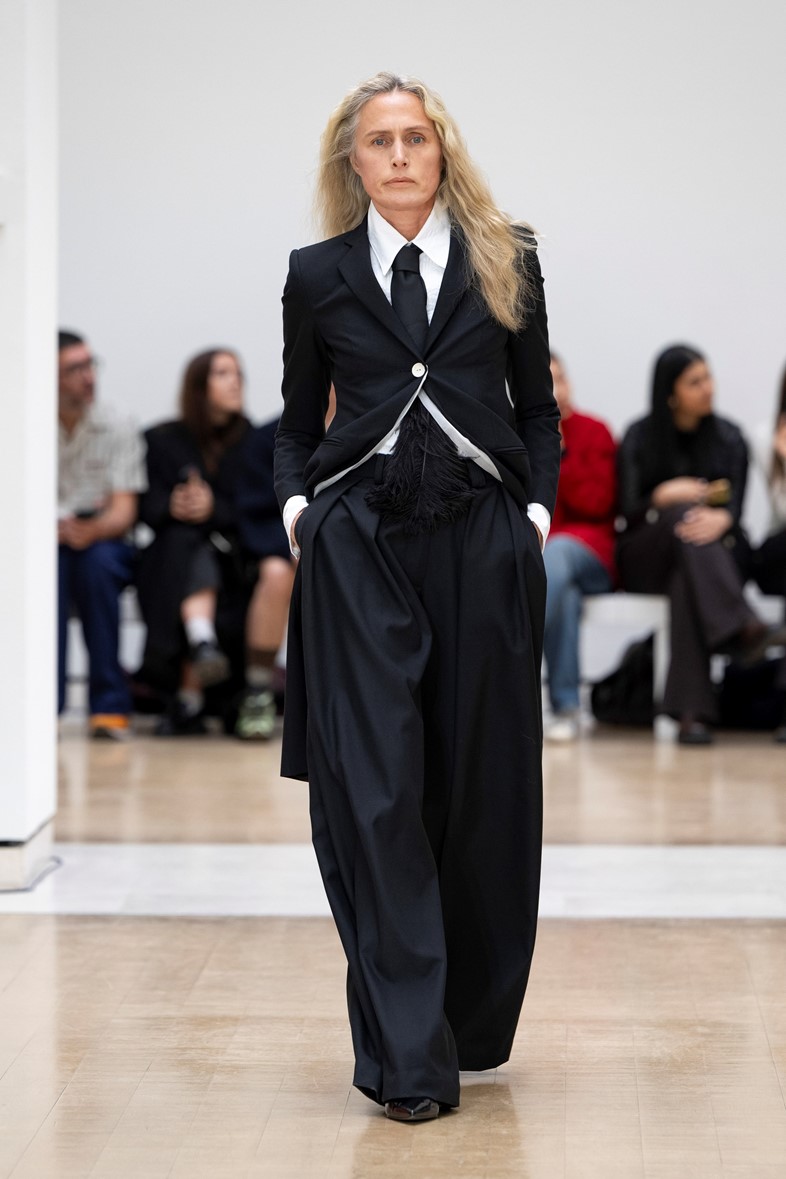The great lesbian renaissance of 2024 has infiltrated every cornerstone of culture this year, from TV (the BBC’s I Kissed A Girl) to music (Billie Eilish, Chappell Roan, Renée Rapp), and film (Driveaway Dolls, Love Lies Bleeding), alongside an influx of newly opened bars and club nights. Last weekend, the sapphic takeover spilled into London Fashion Week’s SS25 collections, with many designers looking to queer women for inspiration.
Kicking off London Fashion Week on Friday with a starry front row including Harry Styles and Emma Corrin, S.S. Daley cited 20th-century painter Gluck as his muse for SS25. Born Hannah Gluckstein in 1895, Gluck rejected pronouns and often presented as a man – going by Peter or, occasionally, Hig. The British artist only exhibited their work in ‘one man shows’ and, in 1936, painted ‘Medallion’, a brave, hopeful self-portrait in which they appear alongside lover and philanthropist Nesta Obermer. The artwork became one for the queer history books; a groundbreaking public display of lesbian love.

Like Claude Cahun, the surrealist photographer working in Paris at a similar time, Gluck played with gender and used their wardrobe as the vehicle. To mark Steven Stokey-Daley’s debut womenswear collection, the designer featured Gluck’s tailored daily uniform: a black wool day coat, high-collared shirt and wide-leg trousers. “Gluck used clothing to curate their identity,” explained Stokey-Daley, showcasing a hard yet soft, elegant and refined collection, plucked from the world of an often-undersung, pioneering British artist.
Coincidentally, Gluck’s ‘Medallion’ also appears on the front cover of arguably the most famous novel in lesbian literature, Radclyffe Hall’s The Well of Loneliness (1928). Which, by chance, was the catalyst for Erdem’s SS25 womenswear collection. The novel, though harrowing, is known today as one of the earliest examples of lesbian literature, and as a result, was banned shortly after its publication. “I would rather give a healthy boy or a healthy girl a phial of prussic acid than this book,” read a review in the Sunday express.

Just as Erdem and S.S. Daley are creative acquaintances, so were Hall and Gluck. Held on the steps of the British Museum, the opening look at Erdem Moralıoğlu’s show was a double-breasted pinstripe suit, notably, with a monocle adorning the lapel (monocles were a staple of early 20th-century lesbian dressing – there was even a basement bar for Parisian lesbians named ‘Le Monocle’). The opening page of the book was sewn onto the sleeve, a recurring motif throughout the show.
Contrasting the masculine silhouettes came a slew of Erdem’s classic evening gowns, decorated by symbols of nature – in particular, carnations, which just so happened to be the main reference point of Simone Rocha’s collection earlier that day. Rocha’s SS25 show at the Old Bailey also inverted the stereotypes of gender, showing menswear in pastel pinks, ballet shoes and featuring an abundance of carnations. Less a symbol of lesbian identity and more a code of gay men, the flower was popularised by Oscar Wilde in 1892 when he asked friends to wear a green carnation on their left lapel to signify their gay identity.
In photos: Simone Rocha’s ballerina-inspired show37 Images
On Monday evening, Irish London-based designer Sinéad O’Dwyer brought us back to the 21st century with her presentation: ‘Everything Opens to Touch’. As the name suggested, the presentation certainly delivered on the heavy touching. Calling upon Lover Management, a creative agency specialising in intimacy and the erotic, O’Dwyer’s collection was worn by three couples, all caught in the throws of passion. Queer women kissing, embracing, and well, getting it on, between unruly ferns and long grass. Often featuring queer casting in her shows, this season O’Dwyer’s models came via the East London Stripper Collective.
The intensity of the models’ interactions divided the audience. The saying ‘not in front of my kids’ springs to mind, with many online trolls unused to being confronted by hot ‘n’ heavy, queer PDA, particularly between women or gender non-confirming individuals. In the comments section, some protested that the presentation was overly, unnecessarily, sexual. Sure, it was steamy. But with lesbians so frequently sexualised by straight people, aren’t the haters just inadvertently revealing themselves as culprits of this? Either way, it was hot. And with so much of fashion based around shock and sex, the prudes will no doubt be ruffled by something else imminently.
Elsewhere, Estonian designer Johanna Parv sent models down the catwalk in her strong, high-tech athleisure, which she previously described to Dazed as being for “Masculine women. Androgynous. Some people say, ‘Johanna likes to go for the lesbians!’” And on Monday evening, Mowalola put on an unforgettable fashion show-cum-performance piece, partially inspired by queer electro-punk musician, Peaches.
From the legendary lesbian figures of days past at S.S. Daley and Erdem, to the future-forward queer women of Sinéad O’Dwyer, or even the clinking carabiners of Chopova Lowena, the lesbian renaissance continued to burn bright through London Fashion Week. That said, while lesbian aesthetics dominate the catwalks, queer women are no trend. We’ve always existed and always come with our own set of clothing semiotics. When in the past lesbians have been stereotyped as women without style, now it seems, lesbian lore is providing the foundation for designer collections. How the tables have turned.
